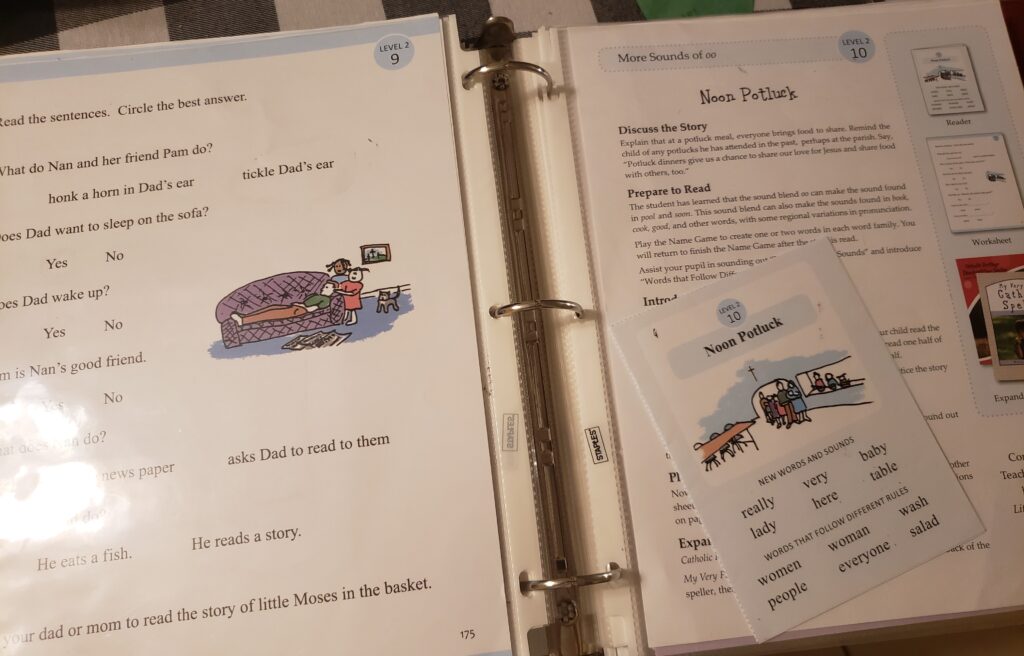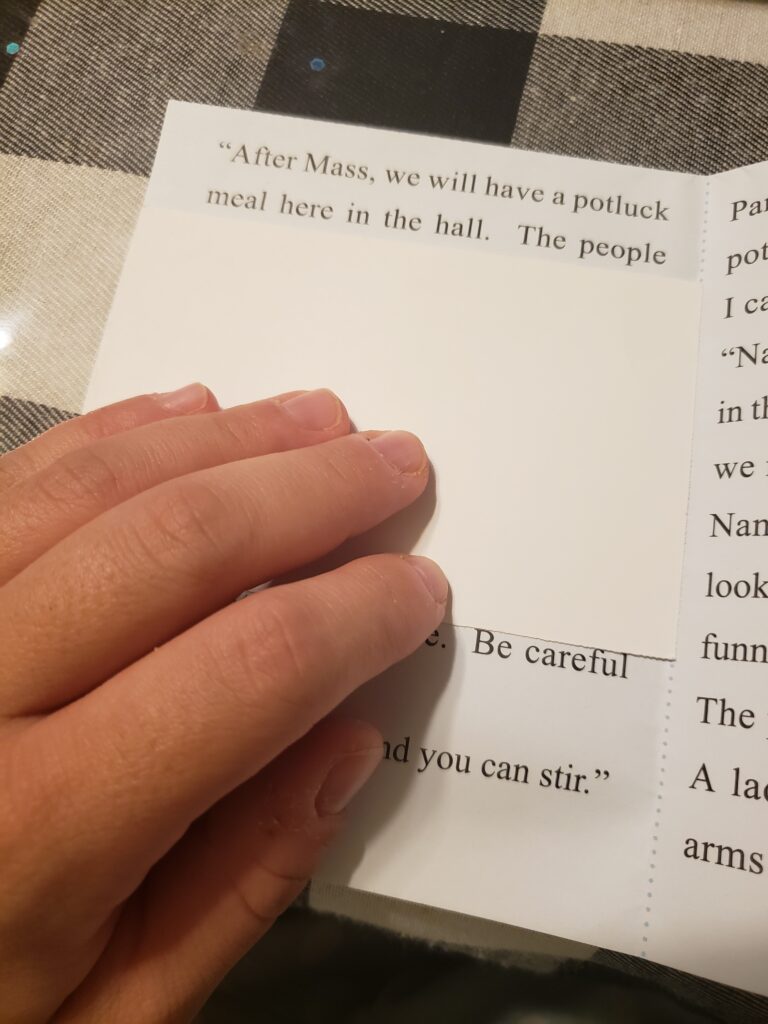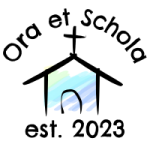Sharing is caring!
I purchased CHC’s Little Stories for Little Folks with my own money. I am receiving no compensation for this review, and the thoughts and opinions are honest and my own. I do not work for Catholic Heritage Curricula, and I am, in no way, affiliated with them. It is simply something we love and use in our homeschool and wish to share with you!
Teaching your child to read is a lot of hard work, but an extremely rewarding experience. There are many reading curricula on the market, and a phonics-based approach is what you want to look for. Catholic Heritage Curricula’s phonics curriculum, Little Stories for Little Folks, provides a solid foundation in phonics. Not only will your child be a fluent reader by the end of this program, but they will also have the joy of reading beautiful stories about the Catholic Faith along the way. In this post, I will provide a review of the Catholic Heritage Curricula (CHC) phonics program for kindergarten and first grade.
Today, I will discuss:
- Program overview
- Types of activities in the program
- How to use the program
- Pros and cons
- Final thoughts
The Catholic Heritage Curricula Little Folks reading curriculum is a wonderful and effective phonics program for your student to learn to read in grades K-1st. Let’s dive in so I can share what I love about it!
An Awesome Phonics Curriculum for Kindergarten and 1st Grade
The Catholic Heritage Curricula Little Folks reading curriculum is designed to teach a child to read starting in kindergarten and lasts through the end of 1st grade. You can start your child earlier or later depending on their interest and skills.
That said, it really is important to wait until your child is ready and showing interest in learning to read. Some signs to look for are recognizing letters, “reading” books by making up their own story while turning the pages, and being open to learning letter sounds when you point them out. This could be before, during, or after kindergarten. Every child is different!
If you start the program and the child doesn’t seem ready, simply spend more time on the early exercises. When your child is ready to read, it will proceed very smoothly with this curriculum.
1. What is included in the Catholic Heritage Curricula phonics curriculum?
You will receive a consumable book with cards for learning letter names and sounds as well as cards to play games that teach grammar in the later lessons. There are also cards that help teach various phonics rules (such as silent gh, vowel blends, etc.) In each lesson, the student will also receive a small book that is torn out of the workbook. There are a total of 45 readers in the entire program.
Most of the early lessons also include a worksheet to reinforce and practice different components of the lesson. The early worksheets involve circling the answer and filling in blanks.
The books also includes incredibly detailed and thorough instructions for teaching phonics to your children. Do not skip this! Follow the instructions exactly as outlined in the manual. It tells you exactly when and how to progress through the program in a way that will best serve your child. It even includes suggestions for further practice and FAQs with many suggestions for “distracted or less-than-enthusiastic readers.
Lastly, the curriculum includes progress checklists for the student. The student may add a sticker or check mark upon completion of each lesson. At the end, the student receives a special certificate of completion! Both of these components highly motivated my girls throughout the program!
2. Types of Activities
In the early lessons, each tear-out book has exercises on the back called “The Name Game”. These enforce word families and rhyming and prepare the student beautifully for the story they will read. The story will included these words and word families. PHOTO OF WORD FAMILIES
There are also active learning games for learning letters and letter sounds, the Silly Willy Sentence game for learning grammar, pages to add stickers or check marks to keep track of your child’s progress, and a certificate to give your child upon completion of the program.
There is also the option to “Expand the Lesson.” Catholic Heritage Curricula has developed a Spelling and Handwriting series that corresponds beautifully with the phonics program. I highly recommend using these along side the program when your child is ready. If it is too much, however, you can scale back on these and still get a lot out of the program. Just add them back as your child is ready for more formal spelling and handwriting.
3. How to use this homeschool reading program
As stated previously, everything is laid out for you in this program. You simply read the parent instructions and follow them at your child’s pace. You can go as quickly or as slowly as your child needs. The program follows the same order and format throughout each lesson, so the child can know what to expect.
This program is open and go which means there is no prep work for the parent. Each lesson provides a script and order to follow. The lessons are meant to be completed over 4 days, spending up to 20-30 minutes a day. Again, it is very easy to adapt this to children who need to go faster or slower.
4. Pros
The pros for this phonics program heavily outweigh the cons. Here are the things I love about this program.
- Solidly Catholic – The main thing that drew me to the Catholic Heritage Curricula program is that it is solidly Catholic. The first story the child will read is called “At Mass.” The stories that follow are beautiful stories about the Catholic Faith, homeschool families, Mass, adoption, and more.
- Affordable – Second, you cannot beat the price! This reading program will take you through kindergarten AND 1st grade for $36.50. This is a phenomenal price for such a solid and thorough program.
- Complete – This program is not missing anything. It will take you from teaching your child the letter sounds to reading at a 2nd or 3rd grade level by the end. This is completely accurate! Your child will have a firm phonics foundation by the end of 1st
- Simple and organized – This reading program is simple and organized. Each lesson is laid out in an easy-to follow fashion and each lesson follows the same flow and format.
- Lots of words – I also love that the readers have very little pictures and the pictures that are included are not distracting. The simple drawings enhance the stories and are appealing to children.
- Introduces and enforces basic grammar – Another thing that really appealed to me about this curriculum is that it teaches and enforces basic grammar throughout. My the end of the program, your child will be able to identify nouns, verbs, adjectives, and more. This sets them up well to begin Grammar study in 2nd grade.
- Corresponding spelling and handwriting – One thing that I felt was missing from other programs we tried was a strong corresponding spelling program and handwriting programs. CHC has both and they are amazing! (Spelling link and handwriting link) The curriculum will prompt you when to use these.
- Gentle but effective – All of CHCs materials are gentle yet extremely effective in teaching children the material. Working on Little Folks for just 20-30 min each day is doable and will get the job done. This has been a truly enjoyable program for us, and I am happy to report that it really is true that child will be reading at 2nd or 3rd grade level by the end!
- Open and go – Open and go means that you literally open to the day’s lesson and go! No prep work is required and no other materials are required. I also have a way to make the program even easier to use by doing one simple thing. I will discuss that below.
- Additional reading material – Lastly, there is plenty of reading material available when child is ready for longer and more challenging books. We have enjoyed the What do you like… and What Can You Do… The stories are wholesome and adorable, and my kids love the journal prompts. We have also thoroughly enjoyed Bigger Stories for Little Folks and Devotional Stories for Little Folks series that follows. I recommend them all!
5. Cons
There are a couple of things that may be cons to some homeschoolers, but are by no means deal breakers, in my opinion.
- The program is consumable – The program is completely consumable meaning a new program will have to be purchased for each child. The worksheets and books require the child to write in them. The low price makes this somewhat more manageable.
- Tear off pad – Since the small reading books are meant to be ripped out, the entire book can be ripped out. It has a loose, glue binding. However, I overcame this shortcoming by taking the entire book apart. Then, I filled the binder with page protectors and put each page in a protector, This actually worked well, because I also put the little book and any needed phonics cards together in one sheet like this:

- Lack of photos can be a con for some – I think the lack of pictures is done on purpose to force the child to read the words instead of using photos to allow them to guess the word. I think this actually works really well and forces them to quickly rely on phonics. Some children may take longer to adapt to the pages filled with many words and few pictures. If they do, you can use an index card to cover the words underneath the line they are reading like this:

6. Final thoughts
We absolutely love Catholic Heritage Curricula’s phonics program, Little Stories for Little Folks. It beautifully weaves in the Catholic faith. It also teaches children to be strong and confident readers in a gentle but effective way. I was so pleased with the way my children learned to read.
Teach Your Kids to Read with a Solidly Catholic Curriculum
I hope you found this review helpful, and I hope you will feel confident that you can teach your children to read. It is also a wonderful program for helping you teach the Catholic faith to your children and glorify God in all that you do.
Sharing is caring!
